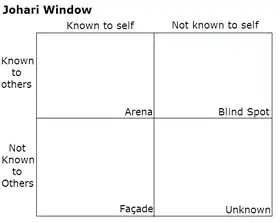Johari window
The Johari window is a technique[1] designed to help people better understand their relationship with themselves and others. It was created by psychologists Joseph Luft (1916–2014) and Harrington Ingham (1916–1995) in 1955, and is used primarily in self-help groups and corporate settings as a heuristic exercise.[2][3] Luft and Ingham named their model "Johari" using a combination of their first names.

Description
In the exercise, someone picks a number of adjectives from a list, choosing ones they feel describe their own personality. The subject's peers then get the same list, and each picks an equal number of adjectives that describe the subject. These adjectives are then inserted into a two-by-two grid of four cells.[4]
In Inside Organizations: 21 Ideas for Managers (1990), Charles Handy calls this concept the Johari House with four rooms. Room one is the part of ourselves that both we and others can see into. Room two contains aspects that others see but we are unaware of. Room three is the unconscious part of us that neither we ourselves nor others see. Room four is the private space we know but hide from others.[5]
The four quadrants
- Arena/Open
- The open area is that part of our conscious self – our attitudes, behavior, motivation, values, and way of life – that we are aware of and that is known to others. We move within this area with freedom. We are "open books".
- Façade/hidden
- Adjectives selected by the subject, but not by any of their peers, go in this quadrant. These are things the peers are either unaware of, or that are untrue but for the subject's claim.
- Blind Spot
- Adjectives not selected by subjects, but only by their peers go here. These represent what others perceive but the subject does not.
- Unknown
- Adjectives that neither the subject nor the peers selected go here. They represent the subject's behaviors or motives that no one participating recognizes – either because they do not apply or because of collective ignorance of these traits.
Johari adjectives
The participant can use adjectives like these as possible descriptions in the Johari window.[6]
- able
- accepting
- adaptable
- bold
- brave
- calm
- caring
- cheerful
- clever
- complex
- confident
- dependable
- dignified
- empathetic
- energetic
- extroverted
- friendly
- giving
- happy
- helpful
- idealistic
- independent
- ingenious
- intelligent
- introverted
- kind
- knowledgeable
- logical
- loving
- mature
- modest
- nervous
- observant
- organized
- patient
- powerful
- proud
- quiet
- reflective
- relaxed
- religious
- responsive
- searching
- self-assertive
- self-conscious
- sensible
- sentimental
- shy
- silly
- smart
- spontaneous
- sympathetic
- tense
- trustworthy
- warm
- wise
- witty
Motivational equivalent
The concept of meta-emotions categorized by basic emotions offers the possibility of a meta-emotional window as a motivational counterpart to the meta-cognitive Johari window.
Therapy
One therapeutic target may be the expansion of the Open (Arena) square at the expense of both the Unknown square and the Blind Spot square, resulting in greater knowledge of oneself, while voluntary disclosure of Private (Hidden or Facade) squares may result in greater interpersonal intimacy and friendship.[7]
See also
- Assertiveness – Capacity of being self-assured without being aggressive to defend a point of view
- Shadow – Term in Jungian psychology
- There are known knowns – A phrase, where its opposite, unknown unknowns, was created with the Johari window
References
- Luft, J.; Ingham, H. (1955). "The Johari window, a graphic model of interpersonal awareness". Proceedings of the Western Training Laboratory in Group Development. Los Angeles: University of California, Los Angeles.
- Pearl, Judea (1983). Heuristics: Intelligent Search Strategies for Computer Problem Solving. New York, Addison-Wesley, p. vii. ISBN 978-0-201-05594-8
- Emiliano, Ippoliti (2015). Heuristic Reasoning: Studies in Applied Philosophy, Epistemology and Rational Ethics. Switzerland: Springer International Publishing. pp. 1–2. ISBN 978-3-319-09159-4.
- Luft, Joseph (1969). Of Human Interaction. Palo Alto, California: National Press. p. 177.
- Handy, C., Inside Organizations: 21 Ideas for Managers, pp 65-70, accessed 1 September 2023
- Staff (2006). "Johari Window". kevan.org. Retrieved 24 November 2014.
- Perry, P. (2010) Couch Fiction. pp. 123–124.
Further reading
- Kormanski, Luethel M. Using the Johari Window to Study Characterization - JSTOR. 1988, https://www.jstor.org/stable/40029904.
- Newstrom, John W., and Stephen A. Rubenfeld (1983). “The Johari Window: A Reconceptualization.” Developments in Business Simulation and Experiential Learning: Proceedings of the Annual ABSEL Conference, https://journals.tdl.org/absel/index.php/absel/article/view/2298.
- Luft, Joseph (1972). Einfuhrung in die Gruppendynamik. Ernst Klett Verlag.
- Hase, Steward; Alan Davies; Bob Dick (1999). The Johari Window and the Dark Side of Organisations. Southern Cross University.
- Handy, Charles (2000). 21 Ideas for Managers. San Francisco: Jossey-Bass. ISBN 0-14-027510-X.
External links
- Noogenesis article on the Johari Window, Examples of window-altering actions; game theory aspects.
- Online Johari Window tool, by Kevan Davis
- Johari Window - downloadable application - Fox Valley Technical College